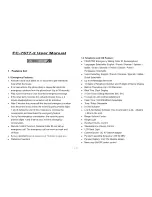
N
ORTEL
TPS 3D S
ENSOR
AND
D
EFENSE
C
ENTER
I
NSTALLATION
G
UIDE
R
ELEASE
4.7.0
PAGE
15
Chapter 1: Before you begin
Other deployment options
The following sections describe other installation scenarios that may affect your
enterprise’s deployment of the Nortel 3D System.
•
“Integrating with VPNs” on page 15
•
“Detecting Intrusions on other points of entry” on page 15
•
“Deploying in Multi-Site environments” on page 16
•
“Integrating 3D Sensors with RNA within complex networks” on page 17
2
Integrating with VPNs
Virtual private networks, or VPNs, use IP tunneling techniques to provide the
security of a local network to remote users over the Internet. In general, VPN
solutions encrypt the data payload in an IP packet. The IP header is unencrypted
so that the packet can be transmitted over public networks in much the same way
as any other packet. When the packet arrives at its destination network, the
payload is decrypted and the packet is directed to the proper host.
Because network appliances cannot analyze the encrypted payload of a VPN
packet, placing 3D Sensors outside the terminating endpoints of the VPN
connections ensures that all packet information can be accessed. The following
diagram illustrates how 3D Sensors can be deployed in a VPN environment.
Detecting Intrusions on other points of entry
Many networks include more than one access point. Instead of a single border
router that connects to the Internet, some enterprises use a combination of the
Internet, modem banks, and direct links to business partner networks. In general,
you should deploy 3D Sensors near firewalls (either inside the firewall, outside the
firewall, or both) and on network segments that are important to the integrity and
confidentiality of your business data. The following diagram illustrates how 3D
Sensors can be installed at key locations on a complex network with multiple entry
points.
Summary of Contents for Softphone 2050
Page 56: ......
















































